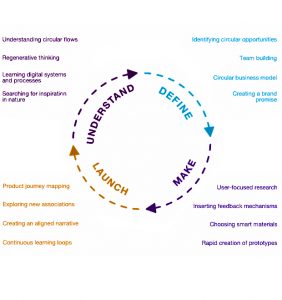
CIRCULAR DESIGN
Design is prominently at the center of the circular economy. It now requires us to redesign everything with a different perspective and insight: spaces, products, business models, cities and linear systems that existed in past centuries. This learning path covers the role of design in creating a circular economy, examining the four-step circular design process, and highlighting six strategies for incorporating circular economy principles into your designs.
Everything that surround
s our living spaces has been designed by someone: the clothes we wear, the devices we use, the buildings we live in, even the way we use spaces. The Montreal Design Statement defines design as “the execution of purpose: the process by which we create material, spatial, visual and experiential environments in a world that has been made more malleable than ever by advances in technology and materials, and that has become increasingly vulnerable to the effects of what is being released ”. global development .”
In other words, design is the way we create and construct products, services, and systems. It is the mechanism by which we shape the material environment around us to meet our needs and desires.
Most importantly, in circular design, important decisions are made that predict and affect when something is designed, how it is produced, how it is used, and what happens when it is no longer needed or desired. It is extremely difficult to undo the effects of these decisions if they are later found to have undesirable consequences.
Design is key to the first principle of the circular economy, “eliminate waste and pollution”.
The truth is, most things are still designed for the linear model today. This means that almost everything has to be redesigned in line with the principles of the circular economy. This means reversible modeling of the design process. The design should not leave a footprint. Each product must return to its starting point and cease to exist there .
The circular design process consists of four stages and is determined by approaches such as design thinking and human-centered design.
Understand – Get to know the user and the system
Define – Put in words the design challenge and your purpose as a designer
Build – Design, design and experiment by prototyping as many iterations and versions as possible.
Publish – Make your design come true and build your story – build customer loyalty and deepen stakeholder investment by telling an engaging story
Design is an iterative process that never ends. You must continually test and improve while understanding how your users interact with your design and how it fits into the wider system.
Traditional design approaches provide a particular focus on considering and meeting the needs of the end user. If we are going to design for the circular economy, we need to look much broader than that, considering not only the user but also the system in which the design will take place. This means understanding the impact of our design on stakeholders and creating feedback loops to help identify and address the unintended consequences of our design decisions. At every stage of the design process, we need to both approximate user needs and zoom out, constantly oscillating between these two equally critical perspectives, taking into account systemic consequences.
There is no one way to design a product or service that does not create waste and pollution, or a business model that keeps products in use for years. The three principles of the circular economy do not dictate the methods that must be achieved, but instead focus on numerous strategies and innovations.
However, analyzing successful cases of circular design in practice illuminates certain strategies that seem more regularly successful than others.
In the circular economy system diagram, approaches such as reuse, sharing, remanufacturing and regeneration are closer to the center of multiple material cycles, while recycling is farthest away. As a general rule, the closer the loop is to the center of the diagram, the more valuable the approximation.
Not surprisingly, many of the most successful examples of circular design are those that prioritize these inner loops of the circular economy. By designing products that can be easily repaired or remanufactured, or creating new business models that facilitate sharing, these businesses are unlocking new value for themselves and their customers.
ate conform to a circular economy.
Extending the life of a product ensures that it stays in use for as long as possible, which is one of the three fundamental principles of the circular economy. This may include designing products to be durable, both physically and emotionally. The designer must be able to bring innovative approaches that allow the product to adapt to the changing needs of the user over time.
Products that resist damage and wear or retain their emotional appeal can potentially be used and reused multiple times by many different users. This includes sharing and using the product by different users . In some cases, as in the Japanese art of Kintsugi, objects can become even more valuable through repair.
Circular design is a large ecosystem. Everything designed within this ecosystem must be designed with all parts of the system in mind. It encourages business models to rethink how we manufacture products and consider the system that surrounds them, but we also need to think about the materials we use. It is important to increase the security of users or to ensure that resources are used repeatedly. Therefore, material selection is very important.
Not all materials are suitable for a circular economy. Some contain chemicals that are dangerous to humans or the environment. Additives are often used unintentionally or for performance indicators such as colouring, flexibility or durability, but there are different ways of designing them. If you can choose materials that are safe and circular, you can create better options for your users and audience while ensuring that the products and services you cre